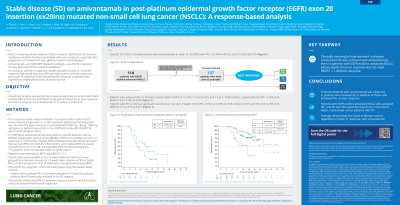Back

Industry Encore Posters
JL1032E: Stable disease (SD) on amivantamab in post-platinum epidermal growth factor receptor (EGFR) Exon 20 insertion (Exon20ins) mutated non-small cell lung cancer (NSCLC): A response-based analysis
Saturday, October 22, 2022
10:00 AM – 11:00 AM ET


Ronni Miller, PharmD, BCOP (she/her/hers)
Medical Science Liaison, Lung Oncology
Janssen Oncology
Evergreen, Colorado, United States
Poster Presenter(s)
Background
EGFR exon20ins NSCLC has been associated with poor prognosis, especially after progression on standard of care platinum-based chemotherapy. Amivantamab, an EGFR-MET bispecific antibody, was recently approved for this population. As anti-tumor activity in single-arm studies typically focuses on complete response and partial response (PR), it is of clinical interest to evaluate outcomes in patients (pts) with SD. A landmark analysis was performed to assess outcomes in pts who achieved SD as best response and did not progress on amivantamab at 12 weeks.
Methods
This analysis included 114 pts with post-platinum EGFR exon20ins NSCLC in the CHRYSALIS study (NCT02609776; 30 Mar 2021 data cutoff). Response was assessed by blinded independent central review using RECIST v1.1. Pts alive at landmark of 12 weeks were grouped by response observed at 12 weeks (PR or better [PR+], SD, or progressive disease [PD]). Progression-free survival (PFS) and overall survival (OS) by responder cohort were estimated using the Kaplan–Meier method, and hazard ratios (HR) and 95% confidence intervals (CI) between response cohorts were estimated using Cox proportional hazards regression.
Results
Among pts alive at week 12 (n=107), 42 (39%) had PR+, 52 (49%) had SD, and 13 (12%) had PD. Among pts with PR+ and SD, the median PFS was 12.2 mo and 7.0 mo, respectively. A corresponding improvement in OS was observed in pts who achieved PR+ (median not reached; HR vs PD=0.21 [95% CI: 0.08–0.54]) and SD (median 23.0 mo; HR vs PD=0.33 [95% CI: 0.14–0.77]), relative to those with PD (median 14.0 mo).
CI, confidence interval; HR, hazard ratio; NE, not evaluable; NR, not reached; OS, overall survival; PD, progressive disease; PFS, progression-free survival; PR+, partial response or better; SD, stable disease.
Conclusions
Treatment benefit with amivantamab was observed in pts who achieved SD, in addition to those achieving PR+ as best response, with a 67% and 79% reduction in risk rate of death, respectively, compared to those with PD. These data demonstrate the value of disease control, regardless of depth of response, with amivantamab.
Table
Table
To view the table, please click on this link from the e-poster gallery on jadprolive.com
EGFR exon20ins NSCLC has been associated with poor prognosis, especially after progression on standard of care platinum-based chemotherapy. Amivantamab, an EGFR-MET bispecific antibody, was recently approved for this population. As anti-tumor activity in single-arm studies typically focuses on complete response and partial response (PR), it is of clinical interest to evaluate outcomes in patients (pts) with SD. A landmark analysis was performed to assess outcomes in pts who achieved SD as best response and did not progress on amivantamab at 12 weeks.
Methods
This analysis included 114 pts with post-platinum EGFR exon20ins NSCLC in the CHRYSALIS study (NCT02609776; 30 Mar 2021 data cutoff). Response was assessed by blinded independent central review using RECIST v1.1. Pts alive at landmark of 12 weeks were grouped by response observed at 12 weeks (PR or better [PR+], SD, or progressive disease [PD]). Progression-free survival (PFS) and overall survival (OS) by responder cohort were estimated using the Kaplan–Meier method, and hazard ratios (HR) and 95% confidence intervals (CI) between response cohorts were estimated using Cox proportional hazards regression.
Results
Among pts alive at week 12 (n=107), 42 (39%) had PR+, 52 (49%) had SD, and 13 (12%) had PD. Among pts with PR+ and SD, the median PFS was 12.2 mo and 7.0 mo, respectively. A corresponding improvement in OS was observed in pts who achieved PR+ (median not reached; HR vs PD=0.21 [95% CI: 0.08–0.54]) and SD (median 23.0 mo; HR vs PD=0.33 [95% CI: 0.14–0.77]), relative to those with PD (median 14.0 mo).
CI, confidence interval; HR, hazard ratio; NE, not evaluable; NR, not reached; OS, overall survival; PD, progressive disease; PFS, progression-free survival; PR+, partial response or better; SD, stable disease.
Conclusions
Treatment benefit with amivantamab was observed in pts who achieved SD, in addition to those achieving PR+ as best response, with a 67% and 79% reduction in risk rate of death, respectively, compared to those with PD. These data demonstrate the value of disease control, regardless of depth of response, with amivantamab.
Table
Table
To view the table, please click on this link from the e-poster gallery on jadprolive.com

